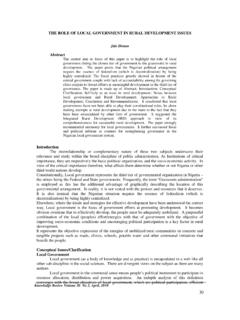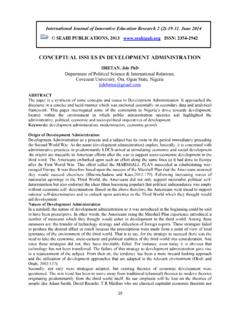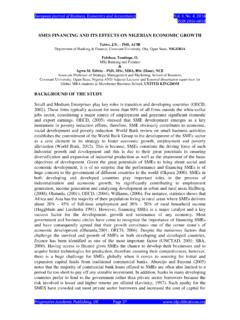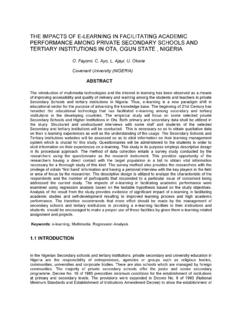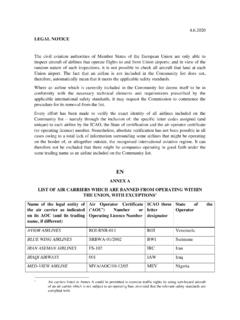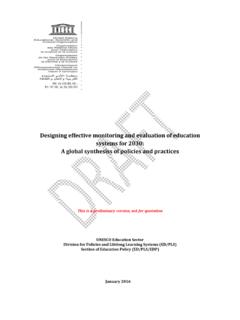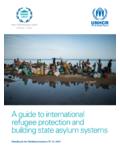Transcription of Types and Causes of Conflict Sheriff F. Folarin, PhD ...
1 1 Chapter Three Types and Causes of Conflict Sheriff F. Folarin, PhD Senior Lecturer and Head of Department Political Science and International Relations Covenant University, Ota, Nigeria +2348030692614 2 Introduction Conflict is as old as mankind. It is a salient feature of the human society. Men must fight even if they do not posses arms or when tools of violence are not within reach; and as Morgenthau (1948) posits, when there are no arms to fight, men will fight even with their bare fists. From birth, a baby begins the journey of Conflict by crying, which is a flash of Conflict . As he grows up, he bites with his teeth or scratches with the nails on his tiny fingers when he is upset. This presupposes that men will continue to fight as long as they have emotions that have the potential to love or hate; to be happy or sad; to be pleased or angry.
2 So long as man has other men around him, there will be issues of disagreement, because interest differs and interests do clash, which may lead to disagreement or confrontation. A community or society of men thus creates room for explosive attitudes and relations. Viewed from an extreme and religious perspective, Conflict represents one of the two natures of man: evil . Cooperation, its opposite, embodies the second, which is the good nature of man (St. Augustine, 1950). Conflict thus manifests in disagreement, anger, quarrel, hatred, destruction, killing, or war. Any untoward attitude capable of charging up the political or social environment is likely to culminate in Conflict . Greed, covetousness, self-centeredness, discontent, envy, arrogance, rudeness, impunity, among other acts, are capable of producing a breakdown of human relations.
3 In a way, these vices are innate attributes of the Conflict nature of man. The foregoing does not suggest that there are no specific Causes of Conflict . Conflict arises for different reasons and there are different Types of Conflict in human society. This chapter delves into the critical question of Types and Causes of Conflict , with the view to addressing the common patterns of most conflicts in human society. What is Conflict ? The previous chapters have addressed the concept of Conflict . We will only be doing a recap to refresh our memory as well as to capture the essence of our discourse and give us a framework for the analysis in this chapter. Conflict is an existing state of disagreement or hostility between two or more people (Nicholson, 1992). By this, it means two or more parties do not have an accord and are as such on two different parallels on the same issue.
4 It thus suggests the pursuit of incompatible goals. Put differently, Conflict means collision course; it also refers to opposition to existing view, stand, or position. In politics, Conflict is more explicitly defined. Conflict is said to exist when two or more groups engage in a struggle over values and claims to status, power and resources in which the aims of the opponents are to neutralize, injure or eliminate the rivals (Jeong, 2000). Conflict is a demonstration of cross-purposes of distinct or similar political groups which often ends in 3 political violence, and political violence, when contextualized in the Weberian sense, according to Anifowose, in his Violence and Politics in Nigeria (1982), is an acceptable weapon to ventilate anger. Goal incompatibility implies opposing or diametrically opposed motives or pursuits. For instance, the United States of America and the Union of Soviet Socialist Republics were pursuing incompatible goals (capitalist democracy and socialism respectively) between 1945 and 1990, an era historically referred to as the Cold War The war implies the Conflict of ideologies and irreconcilability of foreign policies.
5 The period between 1967 and 1970 witnessed the total breakdown of relations and concord in Nigeria, as the East seceded from the federation because of irreconcilable differences with the rest of Nigeria. This led to the Civil War, which further aggravated the Conflict because the East pursued the cause of sovereignty and nationhood, which ran c ontrary to the cause of unity that the Nigerian government pursued. Conflict also connotes different perceptions, which may not necessarily result in hostility. This way, Conflict simply means a different perception or view to an issue or situation (Barash and Webel, 2002). Here, it may mean a different interpretation of a motive, or a different world-view. These include religion, customs, cosmologies or values. Such differences may never culminate in direct and sharp confrontations. On the other hand however, different perceptions, values or world-views may transcend just differences and result in the extreme connotation of Conflict .
6 Inter-faith violence is a critical example of such breakdown. Sometime ago in Nigeria, a splinter group of the Oodua People s Congress (OPC) in the Southwest emerged as a result of growing differences in perceptions, motives interests and values. But soon after, the split and differences led to direct clashes and breakdown of law and order. Conflict may also connote hostility or physical confrontation (Jeong, 2000). When goal incompatibility or perception/value differences reach a crescendo, a manifestation of actual hostility or clashes is possible. In general literature, Conflict is interchangeably used with other terms. This is where it becomes pertinent to mention words or terms that represent synonyms of Conflict . These include contrast, disharmony, discord, struggle, contest, strife, antagonism, controversy, clash, rivalry, contest, contention, brawl, fisticuff, fight, battle, feud, combat and war.
7 In politics, it is not too dissimilar; however, Conflict technically means an existing state of disconnect between two or more parties on a prevailing issue. It is however important to know that Conflict does not always denote war. While all wars are a state of Conflict , all Conflict situations may not be a war situation. Why is this so? War is a state of mutually declared aggression between two or more parties prosecuted by conventional (uniformed and armed) soldiers, with the knowledge and observation of a third (neutral) party 4 who sees to it that acts are within the rules of engagement (Waltz, 2007). Anything less or short of this cannot be the same thing as war. The Conflict in Mali is a state of war. The crisis in democratic republic of congo is however, not war but Conflict . The M23 in DRC is not a conventional army, and it does not have such legal personality to declare war.
8 It is a rebel group that illegally seeks to topple a legitimate government. There have however been some rare exceptions where a war is waged by one or more states against an unconventional army. The war on terror is an example in which a war situation is created as a multinational force legitimated by the United Nations wages a war on Al-Qaeda. What makes this a war is that it is not only collectively executed with the mandate of the UN, but the hitherto faceless Al-Qaeda had declared war on the west and their allies. The Somali crisis can be referred to as Conflict and not war , because the Al-Shabab is an illegitimate Islamist group that seeks most unconventional means to destabilize the state and impose extreme Al-Qaeda Sharia system on a constitutionally secular entity. In both cases, the governments have not declared war, but have only clamped down on such criminal insurgent groups within the state.
9 Conflict is thus related to but technically different from war. Conflict is a general description of a state of chaos, including that of war situations; while war is a legally declared course of action by constitutionally recognized groups. Types of Conflict Experience in human society has shown that there are degrees of variation in conflicts. Conflicts are in Types . Psychology as a discipline has espoused on intra-personal Conflict . Sociology identifies inter-personal as well as intra-group or intra-unit Conflict , as well as inter-group Conflict . Political Science and History have identified inter-ethnic or intra-state Conflict as well as international Conflict . Intra-personal Conflict This refers to a state of implosion in an individual shaped by the state of mind. It is however important to know that such human state is largely dictated by circumstances around him.
10 Such situations are anger, depression, confusion, frustration, which could lead to aggression, erratic behavior, addiction and in extreme cases, suicide (Ross, 1993). This is the kind of Conflict that has been described as man against self (Lamb, 2008), in which man continues to contend or battle with his mind and habits. Smoking, drug use, alcoholism, as well as lying are some addictive habits that man may continually contend with; even when he desires to stop, he may find himself continuing it. This is intra-personal Conflict or man against self . Inter-personal Conflict This is what has been described as man against man in the micro sense. This type of Conflict may be direct opposition, as in exchange of blows, a gunfight or a robbery, or it may be a more subtle Conflict between the desires of two or more persons (Nikolajeva, 2005).


